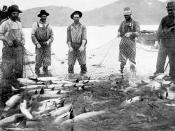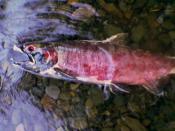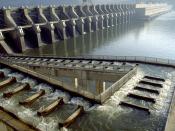The 1,000 plus species of Salmon and Steelhead that live off the western coast of the United States and breed in the rivers and tributaries of California, Washington, and Oregon have greatly fallen in population. 106 species have become extinct and 314 more are at risk of extinction in the Columbia River Basin, the focus of this report. The causes of this are dams on the rivers stopping salmon from breeding and smolt from returning to the ocean, and commercial fishing boats depleting mature populations and blocking river mouths. The solution to commercial fishing problems is obvious, though not likely to happen,as the government won't go farther than lightly regulating commercial fishing boats, but there are several different approaches to allowing the salmon to breed and smolt to return to the ocean despite the dams, though no effective measures have been implemented due to cost or effects on energy and agriculture.
Also, more recently, escaped Atlantic Salmon from aquaculture cages and their offspring are now competing with the native salmon. How depleted are native salmon and Steelhead populations, what has been done so far to boost the populations and has it been effective, and what can be done with dammed river to allow natural breeding? "Salmon Migration: Decisions, Decisions" no author Environmental News Thursday, February 18, 1999 "Columbia River Salmon Protection OK'd" no author Environmental News Tuesday, June 30, 1999 "Dam Busting Not Always the Best Decision" no author Thursday, December 31, 1998 "Columbia River Dams and the Decline of Northwest Salmon" A project developed by April Brenden, Laura Fetherston, Jonette Ford, and Shannon Nichols (Group 30), Biology 130 students at University of Oregon.
Since early times, the rivers of the Pacific Northwest have been filled with salmon. In 1894 Richard Rathbun of the Smithsonian Institute traveled west and commented...


